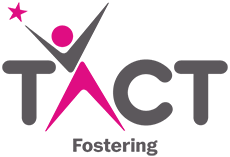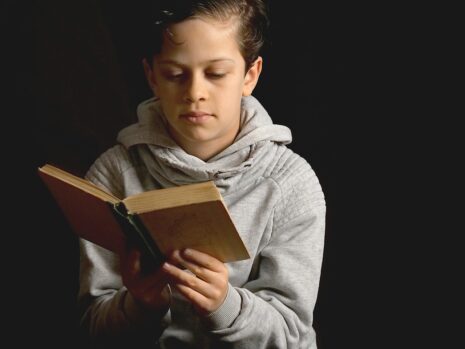Books about fostering can be hugely informative, promoting inclusivity and highlighting the diversity of the family unit. But they can also provide children in care with scenarios and accounts that may be aligned to their own experiences. With the potential to be a guiding and reassuring light at a time of upheaval and past trauma, the value of such publications cannot be overstated.
However, navigating a narrative path through the ups and downs of foster care in fiction can be sensitive and activating for some young people. Plotlines may be too similar to life events, or just too soon in a child’s journey for them to be re-experienced via fiction.
Thankfully, the choice and scope of available reading means that nearly all ages are catered for. For younger children, metaphorical depictions of foster care involving animal characters can be reassuring whilst avoiding potentially activating true-to-life plotlines.
For older children, more realistic plot choices that generate empathy will be more engaging, but also potentially activating. Many of these books will detail the intricacies of care, and can include the origins of any trauma experienced by the characters. However, as many are based on realistic events, the material is generally honest, heartfelt and carefully constructed.
Here at TACT, we’ve listed five books that we think would be a good starting point for any care-experienced young person, across a number of different age groups.
1. A Safe Place For Rufus by Jill Seeney
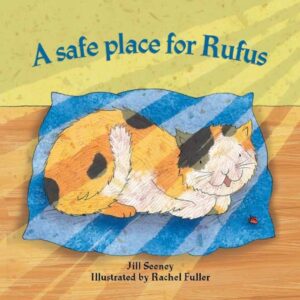
Age group: 4+ years
What is it about?
Rufus is a cat whose previous owners were unkind to him as a kitten. Now in his new home, he realises that he has brought the baggage of his previous experiences with him, and he displays anger. When his current owners are kind to him, will Rufus be won over?
Why do we like it?
A gentle story for very young children, the use of an animal to represent a child works well in terms of communicating past trauma experienced by young people. This avoids more realistic depictions of care that younger children could find activating and upsetting.
The expectation that abuse or neglect will re-manifest despite being in a new family environment is common with young people in care. This is the case with Rufus, who is defensive, guarded and angry when he arrives with his new owners. The story highlights a key responsibility for the new household: to provide a therapeutic and safe base, and to try and unpick negative patterns and cycles previously established.
The small gesture of kindness is important to highlight here: often young people find grand gestures to be overwhelming and alienating. It’s the smaller moments of consideration and support that can truly make a difference.
At the time of writing it, Jill Sweeney was a social worker and trainer, so there is a real sense of careful storytelling in order to convey potentially sensitive material.
2. A Family Is A Family Is A Family by Sara O’Leary
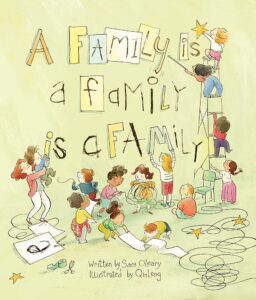
Age group: 4-7 years
What is it about?
A teacher asks her class to think about their families, and what makes them special. One girl is worried that her family is too different to explain. However, as she listens to the other children, she discovers that all families are different in their own way.
Why do we like it?
This story completely side steps any mention of care-experience, and instead focuses on the diversity of the family unit. One child talks about having two dads, one is being raised by their grandmother, and another has stepsiblings.
By avoiding the minutiae of why each household is different, and the potentially activating scenarios that this could bring, it focuses instead on the individuality of all family compositions. By making the theme so universally relevant, any young person reading it will only ever take positive, reassuring and comforting messages from the story.
This book covers the themes of diversity and acceptance in a friendly and heart-warming style.
3. A Different Home: A New Foster Child’s Story by Kelly & John DeGarmo
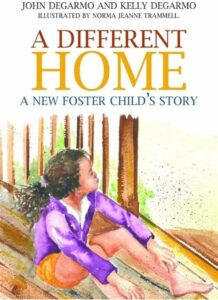
Age group: 5-10 years
What is it about?
When Jessie is placed in foster care, everything appears strange and different. She also has a lot of questions. Jim and Debbie, her new foster parents, answer all her questions and make her feel welcome. Slowly, Jessie begins to realise that her new home is actually quite nice!
Why do we like it?
It is natural for children to feel anxious and that ‘everything is different’ when they first move into a fostering home. Reflecting this in the story from the outset will reassure young people, helping them accept that what is happening to them is not unusual.
When Jim and Debbie answer Jessie’s questions, they establish trust and open a line of communication for Jessie to ask them anything she needs to. This in turn makes Jessie feel better, and her outlook becomes more positive. Demonstrating this supportive and therapeutic approach of foster carers is important to help young people realise that they can feel secure and settled in a fostering environment.
This sensitively written book also comes with notes for adults on how to use elements of the story, and could be used by foster carers, teachers, and anyone else in the care sector.
Kelly and John, the book’s authors, are foster and adoptive parents.
4. Forever Or A Long, Long Time by Caela Carter
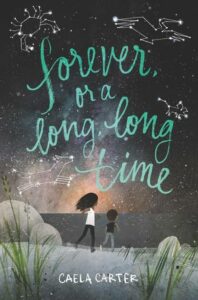
Age group: 8-12 years
What is it about?
After living in many foster homes, Flora and Julian can’t remember where they came from. So they begin a journey to discover their past. Only then can they start to build their future.
Why do we like it?
Many children in care struggle to understand their past, particularly if experiences of trauma have pushed early memories aside.
This book addresses the importance for young people to understand where they came from, in order to better process their present and future. On a practical level, this is often achieved with Life Story Work – which is a compilation of photos, stories and other materials about a young person’s life. This story could be taken as a heartfelt introduction to this piece of work.
Although beautifully and sensitively written, this book can be quite emotional in parts, so we would urge discretion when choosing this for young people.
The author, Caela Carter, has worked with young people for most of her adult life – mainly as a high school teacher of English.
5. Far From the Tree by Robin Benway
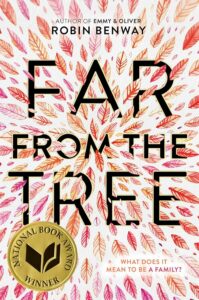
Age group: 13+ years
What is it about?
Three siblings who were separated from each other when coming into care find each other once more. They then need to renegotiate and rebuild their relationships, as well as navigate their current home-life situation.
Why do we like it?
A young adult book, this story covers the complexities of the lives of young people who had to be separated when placed in care.
Keeping siblings together in any form of care is so important, but unfortunately is not always possible. Each character has had their own journey away from their siblings, so this story is an authentic portrayal of these separate lives coming back together.
Any young person who has had to be separated from their sibling(s) will find something that they will relate to here. This story could help open lines of communication between siblings, helping them re-establish their relationship and family bond.
Covering themes of loss, identity and abandonment, this is definitely not an easy read, but is a captivating fictional account of siblings in care.
Many books written about foster care can illicit emotional responses in the reader. However, the books mentioned above have been carefully and sensitively written to shine a gentle light on an aspect of care.
Drawing on authentic scenarios, these stories can be both therapeutic and cathartic for all ages. They can establish and encourage dialogues and conversations about how the subject matter relates to the reader’s own experiences.
But much more than that, they can stand as a reflection of similar voices, events and feelings – which can be reassuring and a step closer to improved mental health and wellbeing.
There are more books about fostering available at Goodreads.
